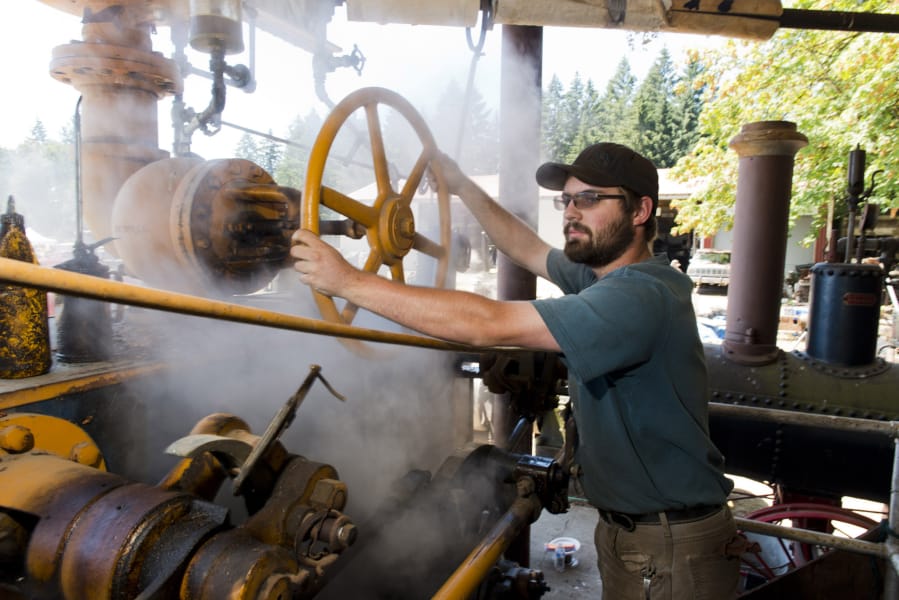RIDGEFIELD — Ryan Johnson sounded the horn over the boiler that powers the big, blue Corliss steam engine, Sunday afternoon to signal the crowd: One of the biggest attractions at Alan Schurman’s “Iron Ranch” was about to lumber into motion.
Shurman’s property in Ridgefield — home to antique machinery from jet-age bicycles to vintage chain saws to a train caboose — played host for the Iron Ranch Antique Tractor, Engine Show and Flea Market over the weekend, the event’s 24th year of celebrating the machines that helped build the modern world.
The Corliss steam engine, named for inventor George Henry Corliss, sits toward the back end of the spread. The big, blue machine is one of the largest on the lot, which included this weekend dozens of vintage gas- and steam-powered tractors and hit-and-miss single cylinder engines.
The Minneapolis Steel & Machinery Company-built engine once powered a sawmill in northern Washington, said Johnson, a friend of the Schurman family who was on hand Sunday to help man the engine.
The 600 horsepower engine, and others like it, could power entire factories. Johnson said the ranch’s engine might have ran five to six saws at a time, on top of planers and other finishing machines.
“A single engine this size would probably power a single, several thousand square foot textile mill,” he said.
For the steam power, they connected it to a steam donkey, a hulking piece of old logging equipment.
The steam donkey at Schurman’s ranch was built in the early 1900s by Willamette Iron Works in Portland.
Loggers would set up the machines in strategic locations around a logging unit, tie cables around fallen trees and its mighty engine would drag the logs where needed.
“It would have been in one place, but then, if they ever needed to move it, what they did is they’d drag a main winch line out to a big tree somewhere and it’d just drag itself around,” Johnson said. “Once they set them up somewhere, they never moved further than just short distances, because it was actually more economical to just abandon it and get a new one.”
On a lot that houses an entire train caboose and an electric generator that powered Eureka, Nev., for decades, the roughly 50,000 pound steam donkey, with it’s 20-foot-tall boiler, is among the larger pieces at the ranch.
“That’s barely enough to turn this engine,” he said, pointing to the Corliss machine. “The boiler to run this engine would have been five times the size of that.”
Jim Barratt’s machines were less purpose-built. Of the dozen or so machines in his display area, many were rudimentary hit-and-miss, single-cylinder engines, most built to power some kind of attachment, such as a saw or pump.
“Old technology,” he said. “Basically this is what you used for power before you had electricity.”
The equipment was less common in the Northwest, he said, since a lot of industrialization had the Bonneville Power Administration to provide electricity.
“Other places, like the Midwest, couldn’t do that,” he said. “They’d use these things for everything. Sawing wood, churning butter, separating milk.”
They were all from the early 1900s, he said. His collection also included a kick-start Maytag washing machine with a clothes wringer attachment.
“You had to fire up the kicker on a washing machine and hope it’ll start, and hope it doesn’t smoke out your neighbors and set the house on fire,” he said.
They’re all his favorites, he joked, but one of his first was an early four-cylinder radial engine from General Motors that, like many of the others, provided direct current electricity power.
It’s been rebuilt several times, he said, from boring out, then re-fitting, the cylinders to overhauling the wiring, and it now has a Chevy piston and Rambler valves.
“There are no parts for these so you gotta mutilate, adapt and sometimes go to the machine shop and get ‘er done, as the Cable Guy says,” he said.
Mike Bjur, a member of the Fort Vancouver Antique Equipment Association and one of the event’s organizers and vendors, said things slowed down a bit Sunday, but Saturday’s turnout was relatively good compared to the last few years.
People will be able to see much of the equipment on display again this summer at the Clark County Fair.
In fact, Bjur said, the club was meeting Sunday to make preparations.
One of the great things about the annual equipment show, he said, is how well-led it is without having any leadership. The show’s been going for years with that spirit.
“This came together by volunteers,” he said. “There’s really nobody in charge, these are people that have done this for years.”




